Abstract
The built environment is an all-encompassing industry. The stakeholders have all reasons to focus on achieving the lowest cost of both initial and investment cost, and the Life-cycle cost has gained increased significance in the construction industry in the past few years. However, the UAE built environment industry is marked with limited adoption of the technique as it still relies on traditional costing models.
The present study has provided a critical analysis of the issues surrounding the awareness, adoption, implementation, possible benefits and challenges associated with the LCC technique in the context of the United Arab Emirates (UAE). The study conducts a detailed literature review to provide key insights into the aforementioned issues under study before an elaborate data analysis is presented to indicate the present situation in the country’s built environment.
The paper also provides key recommendations to help enhance the application and practical implementation of the Life-cycle Costing (LCC) model in both the private and public sectors of the country. Further, areas of further research are suggested to researchers and the government as the need for LCC technique becomes more evident in the current times.
Data presentation and Analysis
Introduction
This chapter discusses the analysis of the collected data obtained with methods discussed in the previous chapter. The data is presented with the use bar graphs and pie charts. The data has been converted into percentages to facilitate for a better understanding and comparison. The interpretation of the collected data is being done establishing linkage with research objectives, research questions and research findings executed in literature review.
Information about the respondents
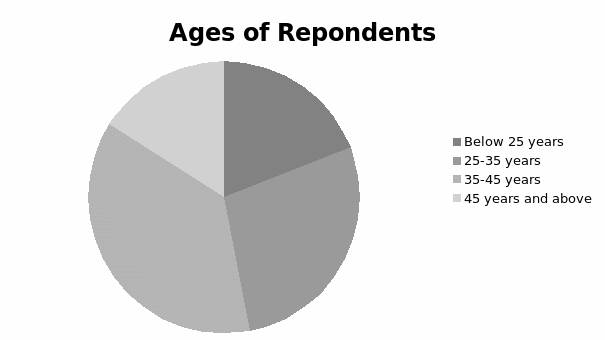
Figure 4.1: Gender
From figure 4.1, it is revealed that the majority of respondents who participated in this survey are aged between 35 and 45 years, followed by the youth particularly new entrants into the construction industry. This information indicates that most of the employees in the UAE construction industry are aged 25 years and above. There are fewer new entrants of the young generation. In this regard, the perception of the modern LCC modern models is seemingly negative. This analysis will be done further in the following sections of this chapter.
Level of Education
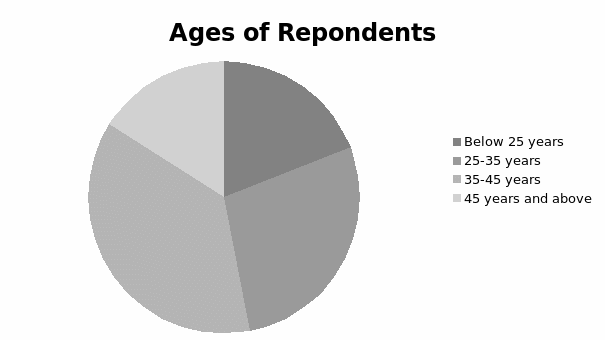
Figure 4.2: Level of Education
The qualification level of the respondents is represented through figure 4.2 that shows that 9% of the participants had an HND degree, 46% of participants had BSc degree, 44% of respondents had a Master’s degree and while none of the respondents had a PhD. This information provides a critical insight into the level of education of the participants. The overall information indicates that the respondents were sampled from qualified and experienced personnel.
Occupations of Respondents
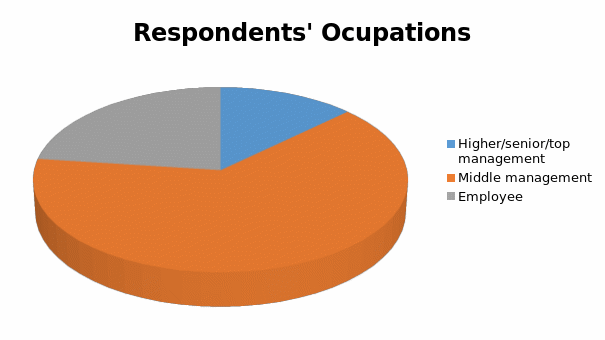
Figure 4.3: Job Occupation
The figure 4.3 shows the job occupation of the respondents and it is revealed from the information that 13% of the participants were top managers and 64% belonged to the middle management. Moreover, 23% of the participants were employees. The middle managers belonged to varied departments including site managers and operations managers amongst others. This data is a viable representation of the workforce from the construction industry. The higher number of the managers is helpful since they are in a better position to provide key information on the implementation and the usefulness, and relevancy of Life costing cycle in the country.
Working Experience
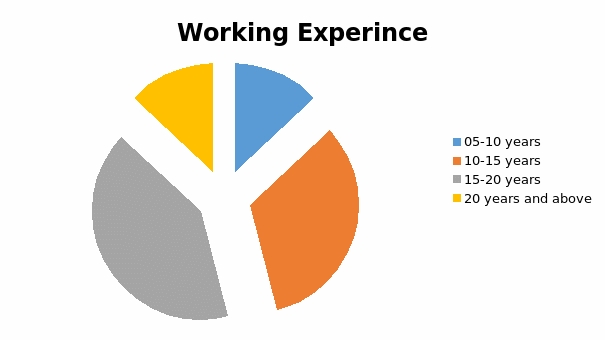
Figure 4.4: Working Experience
Form the above pie-chart in figure 4.4, it is revealed that majority of the respondents who participated in questionnaire survey had 15 to 20 years of working experience in built environment industry of the UAE. The results shows that 13% of the respondents had more than 20 years of working experience, 33% of the participants had working experience of 10 and 15 years.13% of the respondents had worked in the industry for a period not exceeding 10 years.
The responses provide a vital information that majority of the employees have at least 5 years working experience in the built environment industry. Therefore, information provided in the subsequent sections is reliable as it presents significant information on the purpose of this study. Since the respondents have at least 20 years of experience, information on LCC models and the extent of application, effectiveness, and barriers affecting the implementation is easily given (Olubodun et al. 2010).
Theoretical Background on LCC
The information is revealed about the understanding of the respondents regarding Life Cycle Costing is presented in figure 4.5. It was asked how many of the participants have theoretical understanding of LCC in built environment industry. The results show that 76% of the participants have theoretical background on LCC. 24-percent have little or no theoretical understanding of the concept.
This information provides a key insight regarding the knowledge on the concept in the country. Respondents received the theoretical information from workshops and seminars attended during working sessions. The number of participants with no theoretical understanding of life-costing cycle represents those belonging to the executive management. Their responsibilities have no direct connection with construction and the general build environment industry.
Practical Experience of LCC
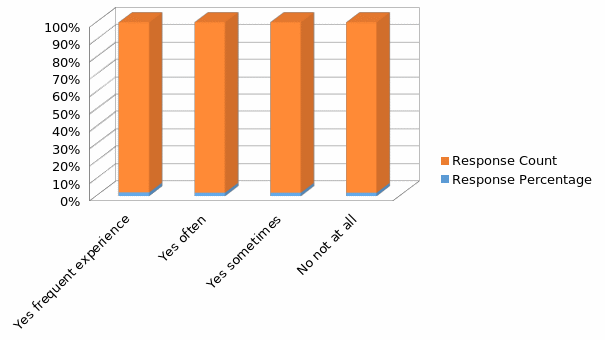
Figure 4.6: Practical Experience of LCC
The respondents were asked about their practical experience of LCC in built environment industry. The results exposed of this question are represented above in figure 4.6.
The information reveals that only 2 percent of the respondents have frequent practical experience with LCC, while 63% have never indulged in it. 13% of the participants have practical experience with LCC, whereas 22% have occasionally been involved but not very often. This information indicates even though majority of the respondents have had theoretical background on the life-0costing cycle technique, very little practical exposure has been done in the country.
The research conducted by Vanier (2001) showed that the level of awareness and usage of LCC analysis in cost evaluation in construction industry of the UAE needs enhancement as this initiative is considered to be still in infant stage.
Accordingly, the construction industry of the UAE is working with an objective to develop itself and to market the products and processes, which are considered more viable environmentally and economically (Olubodun et al. 2010). To achieve this objective, the industry needs to be well aware of the practicality of the LCC technique.
Stage in which LCC is implemented
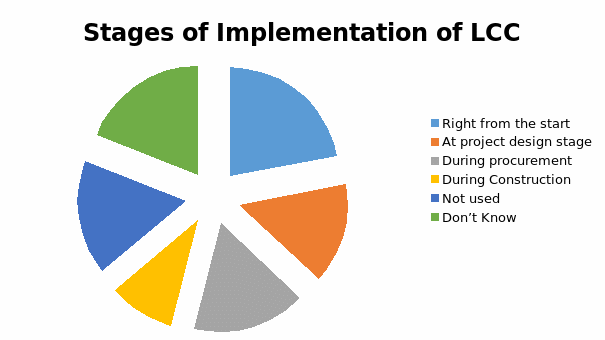
Figure 4.7: Stage in which LCC is implemented
From the figure 4.7, the researcher received information about the stage in which LCC is applied and implemented. The chart reveals that that 22% of the respondents stated that the life cycle costing model is applied from the commencement of the project while 15% said that the LCC is implemented at the design stage.
17% of the participants stated that implementation happens during procurement. 10% of the respondents stated that LCC model is implemented in construction stage. 17% of the respondents reveal that the LCC technique is never applied in the projects they have participated. Others (19%) are unaware if the LCC model is applied or not.
The researcher links information of this question with the research conducted by Olubodun et al. (2010) who stated that while making decisions in all stages such as initiation, operation, maintenance, replacement and disposal during the construction of a project, the construction managers have to bear economic implications.
Moreover, the evaluation of the project costs and implementation of the economic optimization led to the determination of various methods of savings and benefits during the project’s lifecycle that were pursued in the public procurement.
In the UAE, many initiatives are being endorsed to change the approach of the public sector to procure construction projects. The UAE government with particular efforts of construction sector organizations has identified the Life Cycle Costing Analysis as a vital technology of the economic evaluation of a project.
Further, this survey question and information obtained through these questions supports the achievement of research objective 1. From figure 4.7, the researcher analyzes that LCC is applied and is perceived to be the best cost evaluation model at any stage during completion of a project.
Other researchers posit that implementation of the LCC model can take place at any stage but should not be limited to the inception stages of the project. Many project managers only apply the LCC model before the onset of projects and fail to employ in the calculation of operation and maintenance costs. This practice is a source of failure for many projects in the built industry.
Keen in addressing and pursuing LCC
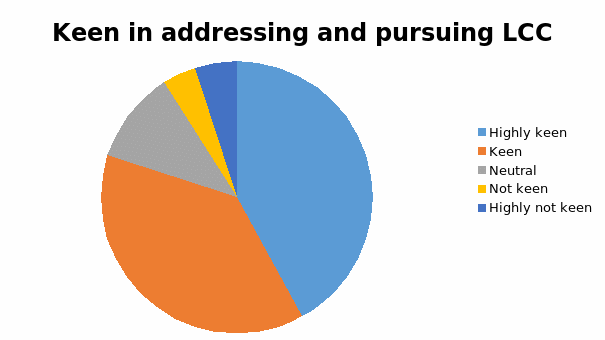
Figure 4.8: Keen in addressing and pursuing LCC
The respondents were asked either they are keen in addressing and pursuing the issue of life cycle costing. From the information in above figure 4.9, it is discovered that 42% of the respondents stated that as a professional they are highly keen in addressing and pursuing life cycle costing. 38% are keen, 11% are neutral, 4% are not keen, and 5% are highly not keen.
The results indicate that majority of the respondents are highly concerned with the pursuit of life cycle costing application in their projects in the built environment. The degree of keenness indicates a positive attitude towards the significance of LCC models in the industry.
The responses to this question align with the views expressed in the literature review that a growing concern over the usefulness of LCC models in the evaluation of project costs. Respondents demonstrate that it is important to be keen while addressing and pursuing the issues of lifecycle costing in a bid to elude room for failure of projects as well as ensuring cost-effective maintenance. As such, overrun costs will not be incurred and projects will not lead to wastage of resources (Vanier 2001).
Frequency of Clients’ Query over LCC
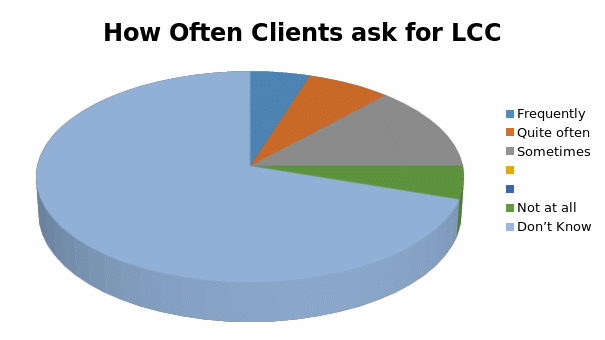
Figure 4.9: Client asks for LCC
The researcher asked the respondents about the frequency of clients’ queries of the application of LCC. The results revealed 5% frequent queries, 7% quite often, 13% sometimes but not always, 5% no queries at all, and 70% of the respondents are unaware whether clients ask about LCC application or not.
From the data obtained, it is evident that clients in the country have little concern over the life cycle coting approach. The information supports the views provided in the literature review that in the UAE construction industry, two difficulties faced by researchers. First, clients in the UAE have minimal understanding of the LCC models as a tool for evaluation of projects’ costs.
As a result, the possibility of subjective decision-making might increase, where project managers choose to ignore the application of the costing approach due to customers’ lack of knowledge of the concept. Second, the UAE clients seem to hold multiple aspects of their needs such that they tend to ignore the issue of assessing long-term costs associated with construction projects. As a result, only few clients ask for the cost valuation model and LCC application.
Importance of LCC in Built Environment Industry
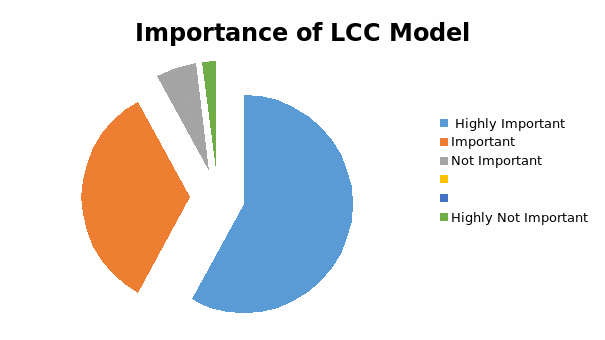
Figure 4.10: Importance of LCC in built environment industry
Figure 4.8 above provides information about the importance of Life cycle costing in built environment industry as perceived by the respondents. The results reveal that 58% of the participants view the implementation of LCC as highly important, 34% indicate that it is vital, 6% deem it not important, and 2% perceive LCC as highly insignificant.
The importance of life cycle costing approach cannot be underestimated, especially in the contemporary world when every little bit of economic aspects of a project attract high attention. This question helps to gauge the stakeholders’ perception of the approach in the built environment context in the UAE.
A great deal of the respondents acknowledges that LCC is a necessity in the construction industry. While addressing the importance of LCC in the construction industry it has been shown in chapter two that various economic benefits are associated with timely implementation of the concept. The economic evaluation and financial optimization of the entire duration of the project’s life are strongly emphasized in public procurement.
For instance, In the UK, bodies such as HM Treasury (2000) and NAO (2001) endorsed numerous advantages and policy regulations to change the public sector’s approach for acquiring construction projects. This question helps to satisfy one of the research objectives of identifying the people’s perception on the importance of LCC in the built environment industry.
Various parameters for LCC emphasized in the UK include service life, life cycle and design life of the project, period of analysis, and costs variables for acquisition costs, maintenance, operation and management costs. It is worth noting that in the UAE most of the stakeholders express their knowledge regarding the usefulness of the life cycle costing technique in calculating those projects’ costs.
Responsiveness of the UAE sectors
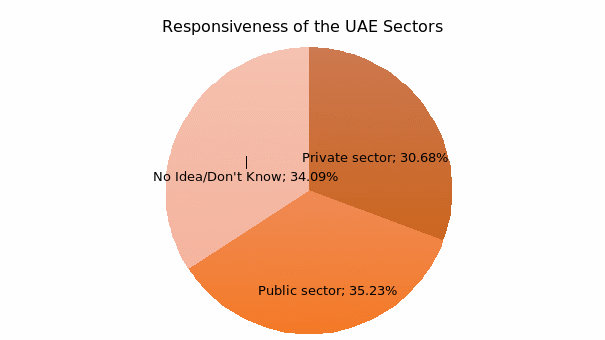
Figure 4.11: Responsiveness of the UAE sectors
The respondents were asked about the responsiveness of the application of LCC in UAE sectors. They were provided with three options, private sector, public sector and the ‘don’t know’ option for this question.
The above figure shows that 31% its responsiveness occurs in the public sector, 27% represents the private sectors, and 30% of the respondents have no idea of the responsiveness of the sectors to the LCC model. Additional research has shown that the public sector leads the way in the adoption of the LCC models in the built environment industry. Its application in the private sectors remains limited. In fact, according to Vanier (2001), the private sector employs unstructured ways of project evaluation processes.
Further, the information obtained corresponds with the research conducted by Gluch and Baumann (2004) indicated that the private sector organizations in the UAE use LCC analysis as a cost evaluation method in unstructured ways for their internal purposes. They rarely depend on LCC calculation for the quality selections.
It is observed that the public sector implements LCC more vigorously and is gaining more recognition than the private sector. Moreover, both public and private construction sectors of the UAE have begun showing a growing trend of utilizing the LCC models for improved economic growth and sustainable development over the last few years (Park 2009).
Adequacy of LCC in the UAE Built Environment Industry
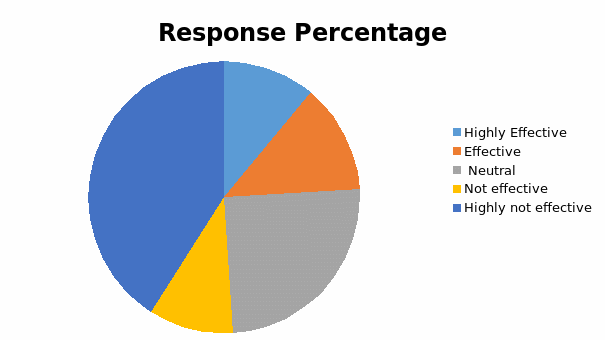
Figure 4.12: Adequacy of LCC in the UAE built environment industry
The respondents were asked of their views regarding adequacy of application of LCC in the UAE built environment industry. The responses indicate that majority of the stakeholders perceive the approach as highly ineffective. Only 11% of the respondents viewed the evaluation tool as highly effective.
Interpretively, the responses show a great portion of the UAE built environment do not acknowledge the effectiveness of the LCC model owing the fact a great number of the stakeholders have not had practical experience using it. On cannot tell the usefulness of a particular concept with no experience utilizing it or even unaware of it.
From figure 4.11, only a small percentage of the respondents have an idea of what LCC model is while the majority of the respondents do not any. In this regard, the perception of ineffectiveness of the LCC tool in the UAE can be attributed to lack of knowledge of the existence of the LCC model and its potential usefulness.
Role of LCC in coming years
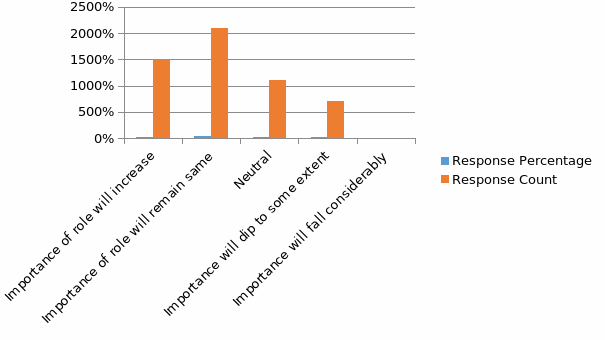
Figure 4.13: Role of LCC in coming years
The researchers asked the respondents of how they see the role of LCC in the future. Majority of the respondents (40%) viewed that the importance is unlikely to change while others (28%) saw the likelihood of the growing importance of the technique in the coming years. 20% of the respondents took a neutral ground on this question while 12% argued that the importance is likely to decline.
Given the small number of experienced and highly learned respondents involved in the survey, the views on likely increased importance of the role of LCC can be interpreted to mean that in the coming years the technique will gain more use.
The growing concern over environmental awareness and the uncertainty of the prevalent economic times does not provide any room of ignoring sustainable development. As such, contractors and project managers will be forced to apply the some form of techniques such as the whole life cycle costing in a bid to prevent unnecessary waste of resources and save time.
Understanding of LCC Models in UAE

Figure 4.14: Understanding of the LCC
The survey also collected information regarding the representation of the stakeholders’ understanding life cycle costing. The researcher asked the respondents if they understand any form of LCC. As indicated above in figure 4.14, only a small portion of the respondents has an idea of what LCC models entail. In fact, approximately 88% of the participants do not understand any form of life cycle costing techniques.
This information demonstrates a very bad state of affairs in UAE built environment industry concerning the application of the LCC approach. Given the few people, having some knowledge of the concept implies that its application remains highly limited. In turn, it shows that the industry has not been cost-effective.
Researchers have attributed too much spending on projects and time wastage to poor planning and lack of techniques for assessing costs associated with the built environment. In view of this problem, lack of knowledge on the approach means that the sector will continue to incur unnecessary costs and witness wastefulness of resources. Research shows that lack of awareness of the life cycle costing approach stems from a number of factors (Norris 2001).
First, there is little experience with the use of the technique because of its complex nature, particularly in using the calculation models. Additionally, the complex models embody too many parameters that act as barriers to the understanding and implementation of the LCC approach.
In addition, the research reveals that lack of motivation in cost optimization is another reason for its scanty awareness among the stakeholders in the UAE construction industry. Because of its complexity nature, it is possible to find that only few people have the willingness to be trained on the use of the technique.
It is probably expensive to obtain training of the complex technique. The UAE built environment contractors have been shown to be highly conservative with budgetary allocations. As such, lack of funding for training on the LCC model is a more likely reason for its little awareness in the country.
Effectiveness and Reliability of the Current LCC in the UAE
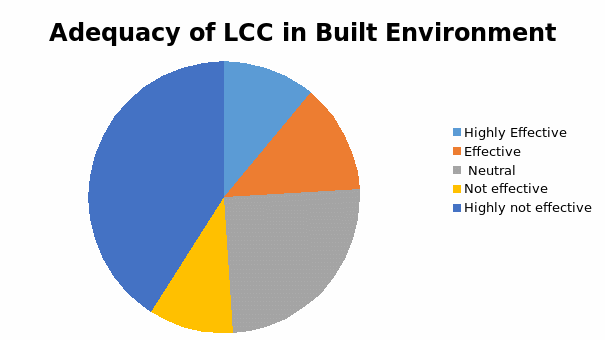
Figure 4.15: Effectiveness and reliability of the current LCC models in the UAE
From the chart in figure 4.15, it 9% of the respondents acknowledge that the currently available life cycle costing models are highly effective and reliable. While evaluating the effectiveness of the evaluation model Vanier (2001) asserted that many of the LCC methods are used to challenge some of difficulties faced in the built environment industry and evaluating initial costs of the project.
The responses provided by the survey indicate that stakeholders in the built environment deem the approach viable and effective. No respondents disagreed with the effectiveness of the LCC model. The responses are in line with numerous researchers such as Vanier (2001) who reveal that through the LCC approach, contractors completed construction projects at lower costs that those that did not adopt the model.
Those that ignored the adoption of the LCC model failed to take into account future costs such as change of use, future energy costs, recycling, and maintenance costs. A growing body of literature agrees with the effectiveness of the life cycle costing technique in the evaluation of costs associated with the built environment industry.
Barriers to implementing of LCC
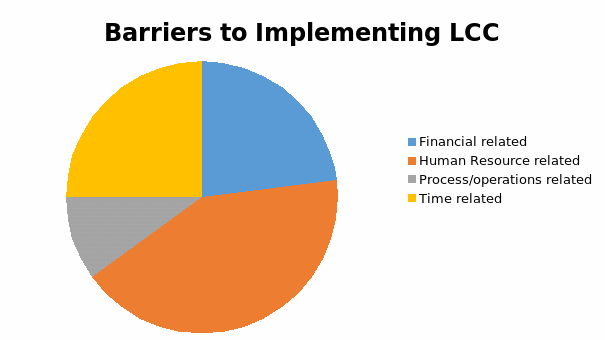
Figure 4.16: Barriers of implementing of LCC
In this question, the researchers enquired form the respondents the types of challenges they think influences the implementation of the LCC technique.
Varying responses were recorded based on financial, human resource, operations, and time constraints. Of these challenges, 42% of the respondents attributed challenges facing the implementation of the LCC technique to human resource management, 25% to time, 23% to finance, and 10% to operations. This question is critical as it provides the researcher with key insights regarding the area that warrants more concern to effect successful implementation of the LCC approach.
Although, majority of the respondents attribute the difficulties to human resource management, an extant body of literature review suggests that the greatest threat to the LCC implementation occurs in finances. Particularly, the industry players in the UAE’s construction sector have a tendency of handling the capital and running costs distinctively.
In this regard, the acceptance of the cheapest initial costs while ignoring the future spending trends are largely inevitable, especially in the private sectors where financial shortcomings can prevail. In addition, due to this ignorance, most of the builders hand over the projects to others to either maintain or complete them.
Moreover, it is seen that the sector does not have a clear definition of buyers and sellers. In addition, the designers and contractors in the UAE have been associated with minimal optimization of costs (Gluch & Baumann 2004). The budgetary allocation of implementing costs evaluation after inception of projects remains highly ignored.
Moreover, operations present another challenge as pointed out in chapter two of the present study. This is particularly inevitable with the difficulty faced while using the data input methods. This problem tends to distort the usual evaluation process thereby leading to the generation of unreliable construction solutions. Besides, several beliefs regarding the life span of the properties and value of the construction components significantly control the length of the contract.
Benefits of Proper and Timely Application of LCC
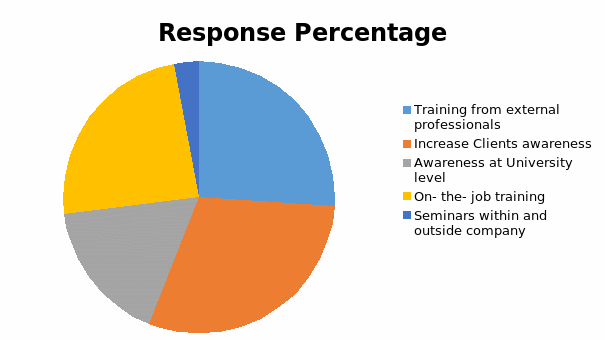
Figure 4.17: Benefits of proper and timely application of LCC
The researcher wanted to know the respondents’ views concerning the benefits of the life cycle costing technique. The responses given show that only 4% of the participants are aware that the LCC model ensures low cost of ownership. In addition, 7% believe that it helps in closing between alternative options at building level, 13% say that it assists in the accurate estimation of service charges, the management of facilities, and budgeting.
Further, 4% of the respondents believe that LCC aids in the decision-making in construction. The majority of respondents acknowledge that LCC has all the four benefits asked. It is evident that the stakeholders recognize the benefits of applying the life cycle costing technique in the built environment (Norris 2001). In light of this recognition, it should be encouraged and more implementation emphasized to prevent the related effects of ignoring it.
Methods for Improving LCC Application
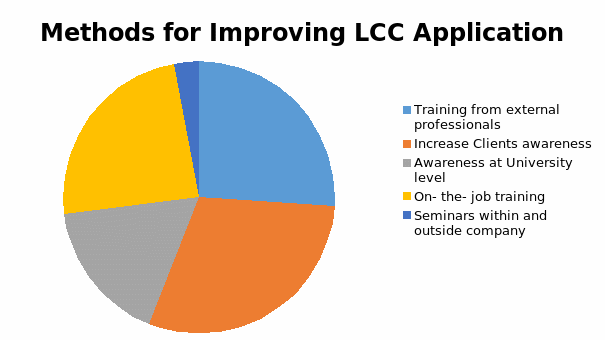
Figure 4.18: Methods for improving the application of LCC
Respondents were asked to give their take on the methods that can help improve the application of the LCC model in the UAE built environment industry. Majority of the respondents (30%) said that increasing clients’ awareness of the approach would be spurring the need for the LCC application.
As pointed out in chapter two, one of the causes of poor implementation of the model is the fact that clients are even unaware of it. Lack of clients’ knowledge of project evaluation techniques provides room for the contractors to ignore the LCC models thereby resulting in adverse effects on the clients including delayed completion and unpredicted costs. 26% of the respondents felt that engaging professionals to train the industry players can increase the application of the LCC model.
Sometimes the expected expertise can be lacking in internal environment of the organizations or the entire industry. For this reason, some respondents said that outsourcing trainers can thus help instill knowledge and enhance the model’s application. Moreover, 24% of the respondents argued that on-the-job training can enhance the LCC application. This study has shown that practical experience with the implementation of the LCC model is very limited in the UAE.
As such, if training can be provided practically on-the-job, it can enable the stakeholders to easily attach its significance through widespread application (Gluch & Baumann 2004). It is better learnt practically than theoretically. Other respondents chose university training as a perfect start for the application of the LCC model (Kishk & Al-Hajj 1999).
Offering the technique as a unit in the university level ensures that the graduates who enter the job market have the skill and a clear understanding of the LCC model and cannot possibly do without utilizing it. Seminars and outside received a 3% response in which the LCC application can be sensitized (Kishk & Al-Hajj 1999).
Conclusion and Recommendations
Concluding Points
The present research study adopted a comprehensive survey to investigate the issue of project life cycle costing in the UAE built environment industry. It aimed at establishing the stakeholders’ perception of the life cycle costing model, its usefulness, the application, implementation, and the challenges that pose difficulty in its adoption. The results indicate that the participants of the survey are a high level of education of at least a bachelors’ degree.
The participants involved individuals at top managerial positions, middle managers, and employees. The survey focused on people currently working in the built environment industry in a bid to ensure responses portray the real situation on the ground regarding the issues of LCC model (Kishk & Al-Hajj 1999).
The research study reveals that despite the concept been in existence since 1970s as terotechnology, the UAE built environment shows limited knowledge and application. The responses obtained indicate that a large number of people in the industry have a theoretical background of the life cycle costing model. However, those with practical experience are exceedingly few. This observation necessitated the researcher to ask additional questions on the clients’ concern over the application and implementation of the LCC technique.
The data collected regarding this question demonstrates a further worrying trend. Clients show minimal concern over the utilization of the LCC model in the management and assessment of projects’ costs. As such, the contractors and project managers tend to ignore the utilization of the LCC model. This ignorance exposes the clients to substantial unprecedented and preventable costs.
The research study identifies key challenges hindering the practical application and implementation of the LCC approach. The challenges are related to human resource, finance, and operations. The HRM roles in the implementation of the LCC are highly neglected in the UAE built environment. The study identifies the HR as a key area of negligence.
Other factors hampering the LCC model implementation are clients’ negligence, and the difficulties associated with the calculation of various unpredictable costs such as operational, maintenance, energy changes, acquisition, and demolitions. The respondents point out that if necessary measures are undertaken, particularly training, can increase the awareness of the effectiveness of the LCC model.
Training can occur at universities, on-the-job training, and workshops and seminars (Norris 2001). The respondents express confidence that the future role of the LCC model remains inevitable. For this reason, the quest for adequate training and awareness cannot be underestimated.
The responses provided support the government’s view of the need for concerted efforts to elude the problems affecting the construction industry in the UAE. In fact, the UAE government is promoting various measures aimed at involving the clients as key stakeholders in the implementation of LCC models.
The awareness of LCC models can be increased through involving the clients in seminars and open workshops. This research study has found out that the expertise on LCC model is limited in the UAE. In this regard, the government is considering outsourcing of professional experts and researchers to provide the training of individual on the best ways of adopting the LCC model in the built environment.
Recommendations and Implications
After the lengthy study regarding the importance of the LCC in the UAE built environment, I offer several recommendations that act can help the organizations to avoid unnecessary costs and prevent major pitfalls in the industry. The recommendations touch on the role of the UAE government, clients, and the architectural contractors.
The UAE Government
First, there is a growing need to abandon traditional methods of investment that is based on capital costs, with the life cycle costing model that relies on the total cost factors. Second, the theoretical exposure of industry stakeholders is not enough. It should be complimented with the practical application of the LCC model for tangible results.
The government of UAE should lead the adoption of the LCC perspective in the built environment industry since the total cost for operations and maintenance of projects and buildings exceeds the capital cost. Given the increasing number of installations and equipment on buildings, the need to implement the LCC approach at all stages remains paramount.
The UAE Clients
The clients are deemed as responsible for the production and development of the construction projects. In this regard, they should be concerned with the long-term economic aspects of those projects. Developing the knowledge of models that will enhance cost-effectiveness of the projects is vitally important. For this reason, clients in the UAE should adopt the LCC and emphasize on its consistent implantation at all stages of the projects. The result will be cost-saving, accuracy, and improved performance (Park 2009).
Architectural Contractors
Research has shown that clients who are the sponsors of the projects tend to be hesitant to pay for project evaluation fees. As a result, the architects provide the largest resistance to apply the LCC techniques. This behavior is a major cause of collapse and even higher operational and maintenance costs in the built environment. To avoid the escalation of this problem, the architects need specify, in the procurement stage, how the evaluation will be performed.
This early indication is likely to enhance the clients’ buy-in and pay for the service. Avoidance of the inclusion of the related parameters of evaluation attracts lawful litigation on the part of the architects (Park 2009). Until this seriousness is accorded to the standards of the built environment in the UAE, pitfalls will always prevail as perceived by the respondents. Architects can also integrate their skills such as green building with the LCC technique for more attractive results.
Lessons Learnt
Various lessons has been learnt from this research study regarding the topic under consideration and the data collected helped a great deal in learning lessons along with wider academic literature. It has been learnt that the implementation of LCC function needs some pre-requisites to consider for the purpose of achieving effectiveness. LCC function should be used right from the start of project especially in build industry where nature projects is sensitive and time consuming along with costly.
It has been learnt that good awareness regarding a concept or function is not enough for achieving effectiveness as the level of awareness about LCC is present in the UAE industry but the implementation is not effective. However, an attitude towards addressing the issues and intention of implementation is positive sign and it has been learnt that managers and firms in the UAE build industry can certainly improve the effectiveness of LCC in coming years (Park 2009)
It has also been learnt that diverse factors are affecting the function of LCC and build industry is not able to address and consider these factors properly for extracting maximum benefits out of it. Capital Cost, acquisition Cost, operating cost and functional areas are prime examples of these factors. It has been learnt that LCC evaluation is imperative for its effective implementation in firms that is dependent on data such as the requirements of building including floor area.
Moreover, it has also been learnt that the requirement from the side of clients is also a decisive factors regarding implementation of LCC in their projects as it will assist in improving the efficiency and effectiveness of this function.
Apart from this it has been learnt that implementation of LCC should be done by experts and experienced individuals rather than inexperienced and general professionals because the barriers cited regarding effective implementation of LCC has been both financial and human resource related. Lastly it has been learnt that recent trends in the build industry regarding increasing and complex demands of business environment and clients, build industry firms will need to respond to these changes for effectiveness of LCC in coming years.
Research Limitations
There are few research limitations in this research study which may have dented the findings and quality of investigation overall. First limitation is the average level of understanding possessed by the researcher regarding the built environment industry of the UAE. In addition, the scanty availability of data about the construction industry and the application of the technique in question provide significant constraints.
Moreover, collecting information from the top managers and executives was difficult. Possibility of obtaining inaccurate data was high since no executive is likely to provide truthful information that jeopardizes their organizations’ image. In addition, some organizations forbid employees from revealing confidential information about the organizations. This culture could a source of inaccurate data.
Personal Reflection
This paper provides an opportunity for the researcher to exercise on the skills regarding the use of survey questionnaires to gather information from a large population. The research provides a vital insight into the degree of acceptance and implementation of the life cycle costing technique in the UAE.
Comparing the level of application and implementation, and the role of stakeholders in the country with the situation in other countries in European Union, indicates that UAE is a bit behind. If the respondents’ views are taken into account, the UAE government can attain measurable milestones in abandoning traditional project costing techniques in the favor of the more comprehensive LCC model.
Suggestions for Future Research
Various research techniques can be utilized to improve the sample size for more accurate data analysis regarding the use application of the LCC technique in the UAE built environment. Further research can provide insight on the role of policy makers on the implementation of LCC models (Kishk & Al-Hajj 1999).
Cost data is considered the most significant input for LCC research and further research on this aspect can provide significant results in terms of its positive impact on applying the LCC technique.
Shift in the worldwide construction industry from the dominant culture of using traditional cost evaluation model to the culture of whole life cycle approach needs to be taken into consideration by potential researchers for the purpose that how LCC can be implemented in line with changing trends in coming years. Additional questions can be asked to provoke further research. Further questions can include:
- What changes on the UAE education sector can be changed to increase awareness of the LCC technique?
- What can organizational managers do to increase awareness of the LCC technique among the employees?
- Can the UAE government succeed in stipulating national regulations as way of enforcing the LCC adoption?
Works Cited
Gluch, P & Baumann, H 2004, ‘The life cycle costing (LCC) approach: a conceptual discussion of its usefulness for environmental decision-making’, Building and environment, vol. 39 no. 5, pp. 571-580.
Kishk, M & Al-Hajj, A 1999, ‘An integrated framework for life cycle costing in buildings’, RICS Research Foundation, vol. 1 no. 1, pp. 7-8.
Norris, G 2001, ‘Integrating Life Cycle Cost Analysis and LCA’, The International Journal of Life Cycle Assessment, vol. 6 no. 2, pp. 118-120.
Olubodun, F, Kangwa, J, Oladapo, A & Thompson, J 2010, ‘An appraisal of the level of application of life cycle costing within the construction industry in the UK’, Structural Survey, vol. 28 no. 4, pp. 254-265.
Park, S 2009, ‘Whole Life Performance Assessment: Critical Success Factors’, Journal of Construction Engineering and Management, vol. 135 no. 11, pp. 1146-1161.
Vanier, D 2001, ‘Why industry needs asset management tools’, Journal of computing in civil engineering, vol. 15 no. 1, pp. 35-43.